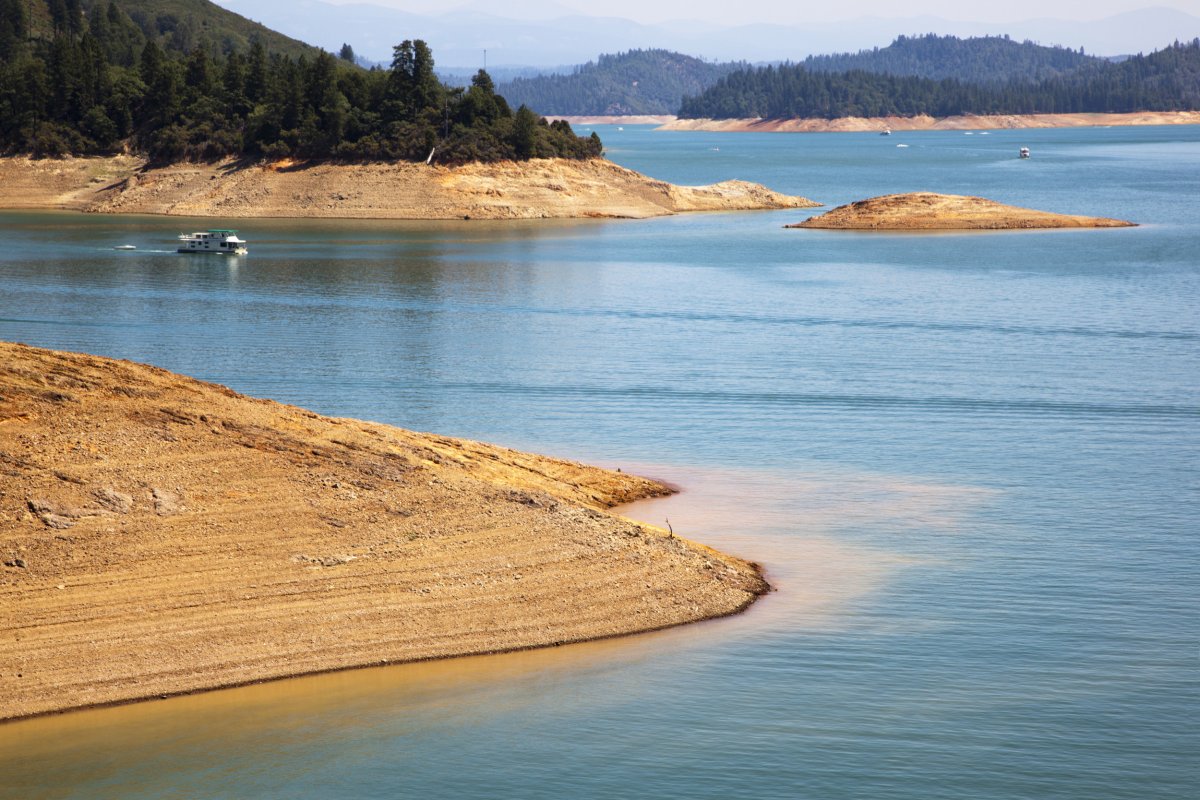Thanks to heavy rainfall across northern California over the past few days, Lake Shasta's water level is now higher than it has been in years.
As of May 9, the lake is at 1,063.77 feet above water level, having risen nearly 150 feet since the start of 2023, when it stood at 928.01 feet.
These water levels are higher than they have been since 2019—both at this time of year and at any point—and currently stand just below the 2019 high of 1,064.5 feet. The lake's current levels are therefore only just 3.2 feet shy of its 1,067-foot capacity.

"Shasta's going to stay pretty full all summer long," Don Bader, the Northern California Area Manager for the Bureau of Reclamation, told Redding news station KRCR. "We're going to go down about 40 feet—40 to 50 feet by the end of September, which the boaters; the marine operators are thrilled because it's going to be great recreation on the lake.
"And then going into next winter, assuming we get just the normal winter storms, we're going to be pumped full next spring at Shasta, which is great for next year. So, we already know going into next year we're totally trending in the right direction here out of three years of drought,"
Lake Shasta, located in Shasta County, California, is the biggest reservoir in the state. Its increased water levels are due in large part to the heavy rainfall that battered the state during the early spring, refilling many of the dried-up reservoirs. On May 9 last year, Lake Shasta only stood at 946.67 feet.
"Statewide the reservoirs are generally in good shape with most at or above their historical averages and some reservoirs having to let significant water go to maintain space for floods," Jeff Mount, a senior fellow at the Public Policy Institute of California's Water Policy Center, previously told Newsweek.
The multiple powerful atmospheric river storms that hit California this year also served to bury the Sierra Nevadas in snowfall, bulking up the snowpack in the mountains to record levels. As the spring temperatures increase, this snow is due to start melting, flowing down the mountains into the valleys and refilling the reservoirs further as part of the "big melt."
"Snowpack provides 30 percent of California's freshwater and plays a critical role in the replenishment of reservoir levels when it melts and increases streamflows in the spring and early summer," Andrew Schwartz, lead scientist and manager at the UC Berkeley Central Sierra Snow Laboratory, told Newsweek in February. "It acts as its own storage system on top of the mountains."
This melt may, therefore, further increase the water levels in Lake Shasta.
However, the melt has also led to flooding in the Central Valley, Lake Tulare, and in Yosemite, and is feared to cause more in the San Joaquin River Basin. Due to the ongoing megadrought plaguing the U.S. West, the soil has become so parched that if the water all runs down at once, it may run over the soil instead of soaking in, causing flash flooding.

While excess water seems like it would be good to lift the state out of drought, the dry soils and flash flooding mean that the depleted yet essential groundwater supplies are not being replenished.
"It will take several years of above-normal precipitation—both rain and snow during the appropriate times of the year," Lara Fowler, an environmental and energy issues attorney and interim director of the Penn State Sustainability Institute at Penn State University, previously told Newsweek.
"As soil moisture and surface water supplies have become depleted, more and more groundwater pumping has also led to a decline in aquifer levels in many places. Such groundwater contributes to baseflows in streams," she said. "So not only would surface water (streams and rivers) need to refill, so does soil moisture and groundwater levels, the last of which can be very slow to recharge."
Do you have a tip on a science story that Newsweek should be covering? Do you have a question about Laka Shasta? Let us know via science@newsweek.com.
Uncommon Knowledge
Newsweek is committed to challenging conventional wisdom and finding connections in the search for common ground.
Newsweek is committed to challenging conventional wisdom and finding connections in the search for common ground.
About the writer
Jess Thomson is a Newsweek Science Reporter based in London UK. Her focus is reporting on science, technology and healthcare. ... Read more
To read how Newsweek uses AI as a newsroom tool, Click here.








